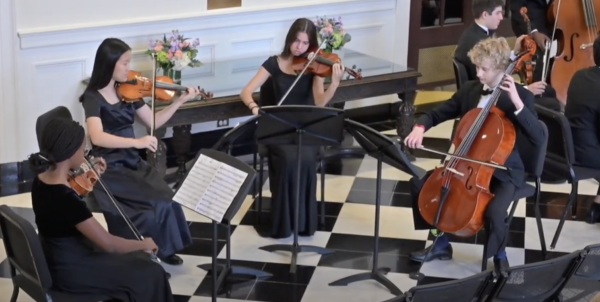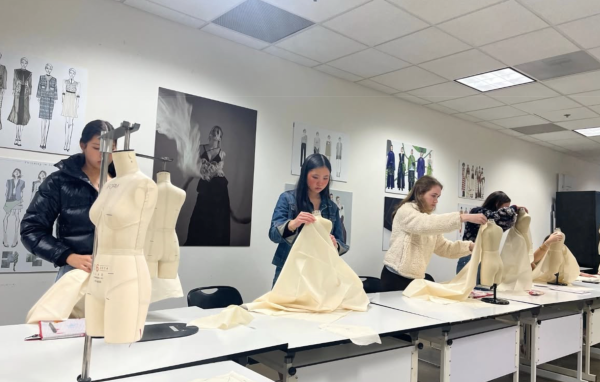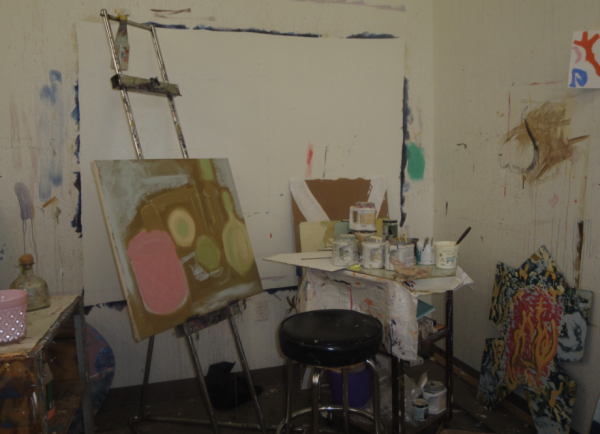STEAM JanTerm visits artist residency
One of the numerous JanTerm courses offered this year is the STEAM Workshop, where students apply science, technology, engineering, art, and math skills to create individual and group projects.
The first week consists of lectures delivered by an array of speakers across the 5 fileds represented, and experimenting with various types of media. The students have to opportunity to cultivate their individual projects in the second week, coming up with ideas, planning, and creating pieces to be displayed in their final show. Yet the most unique aspect of the course was their final trip to an artist residency in Greensboro, North Carolina, from Jan. 17 to 19, where they had the opportunity to collaborate on special projects.
Formerly a thrift shop, the artist residency called Elsewhere was co-founded in 2003 by a Westminster alumnus George Scheer. The residency exists to allow artists space for creative work, and helped the students in their projects. Elsewhere is unique from other artist residencies, and was chose for this specific reason.
“The mission of Elsewhere seemed to align perfectly with our STEAM Workshop class,” said STEAM Workshop co-advisor Benjamin Steele. “We are encouraging students to embark on creative projects that have a foundation on a basis of knowledge found in one of the STEAM subjects.”
Ellen Buchanan, a senior in the JanTerm, felt her art will be better because of visiting the residency.
“Visiting Elsewhere was a very unique way of experiencing different forms of art that we were not exposed to before,” said Buchanan. “We definitely had to alter the way that we were thinking about sculptures and use different materials. It inspired me to think about my final concentration in a different way.”
Buchanan was in the Advanced STEAM Workshop, a subset of the Janterm for students who have taken or are currently taking an AP or studio-level course. The Advanced STEAM students had the opportunity to form critique groups and and help the other students. Steele also explains how the Advanced STEAM students not only helped their peers, but also assisted the teachers.
“We’re working in so many mediums at the same time, it pulls the teachers in a lot of directions,” said Steele. “We’re offering support, but it’s also a significant amount up to the students to figure out how to get the process done… [And] the trickiest part about taking on a major project and completing it in a week, even if you have all day to do it, is the mental time you need to conceptualize something.”
Junior Thomas DeWalt was also in the advanced-level course, and felt that the students truly had the freedom and responsibility to design their own projects.
“The guidelines for the project were purposefully vague so that we could focus on what we were interested in. The teachers really encouraged us to find inspiration and then create,” said DeWalt. “They were there to help us along the way, but it was up to us to find a subject to depict.”
Freshman Nylah Desnoyer’s project was a bird made out of feathers, hot glue, and popsicle sticks, created to simulate how kinetic energy works in relation to organic forms.
“For my specific piece I was inspired by several different things, such as the movement of a bird’s wings, the Strandbeest by Theo Jansen, and A Study in Bird Motion by Joyce Lin,” said Desnoyer. “The wings are connected to popsicle stick gears and flap up and down when the gears are rotated.”
Freshman Catherine Wang’s was similarly inspired by a lecture given during class about the spine. She created a stop motion video on human evolution.
“We briefly discussed vestigial structures such as the tailbone, and this eventually led me to research evolution,” said Wang. “Evolution has been something I’ve been interested in ever since I saw the FRIENDS episode where Phoebe and Ross argue over evolution and the credibility of evolutionary theory. I created around twelve paper models using bits of kneaded eraser, toothpicks, and paper to represent how humans and apes evolved from a common ancestor.”
The students had a whole week to work on their projects, which proved to be more difficult than they had anticipated.
“I realized around Wednesday that I really needed to finish my project, and fast,” said DeWalt. “I started off with a very ambitious idea and had to edit it to fit our week-long timeline.”
After finishing their projects on Friday, the students left early Tuesday morning for Elsewhere for a final project.
“Elsewhere was definitely the best part of the JanTerm,” said Buchanan. “I’ve never been in a space that is so conducive to creating. It was refreshing being in that type of enviroment.”
The students were overwhelmed by how much they learned from the trip and felt that it was an intregal part of the course.
“I would encourage everyone to take the STEAM JanTerm, if not just for the final project,” said Buchanan. “Everyone should have the opportunity to visit Elsewhere. It was so unique and so inspiring.”
Based on the success of this year’s JanTerm and the interest the students took in the project, Steele hopes that students are motivated to sign up for the course in the future.
“[The course] lets a student who’s always had an idea in the back of their head of something they’ve wanted to pursue do so for academic credit,” said Steele. “The ideas in this course could lead you towards really interesting and engaging careers all across the board, from engineers to architects.”



